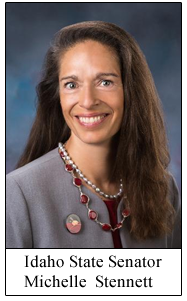June 6, 2018
by Idaho State Senator Michelle Stennett,
Democratic Senate Minority Leader
 An
article in the Twin Falls Times-News late last
month brings into sharp relief a major hurdle
rural Idaho communities must overcome. The story
focused, in part, on Doctor Keith Davis, who
serves the people of Lincoln County. He has been
doing so since 1985. However, that was just the
setup to the story. An
article in the Twin Falls Times-News late last
month brings into sharp relief a major hurdle
rural Idaho communities must overcome. The story
focused, in part, on Doctor Keith Davis, who
serves the people of Lincoln County. He has been
doing so since 1985. However, that was just the
setup to the story.
Doctor Davis is the county’s one and only
doctor. He has been for 33 years.
The article points out that Lincoln County is
roughly the size of Rhode Island. The difference
is, a search of “doctors in Rhode Island”
produces thousands of hits. There are more board
members with the Rhode Island Medical Society
than there are doctors in Lincoln County.
The question the article begs is: what happens
when Lincoln County’s only doctor chooses to
retire?
Rural counties like Lincoln, Camas, Gooding and
others face similar questions. Idaho ranks 49th
in the nation in doctors per capita. One-third
of Idaho’s doctors will retire in the next 10
years. Anyone living in rural Idaho doesn’t need
to look at a list to know this. Securing even a
routine doctor’s appointment can sometimes
require weeks of waiting. According to the
story, Doctor Davis saw over 50 patients on his
first day – including one who gave birth. There
are 27 critical access hospitals (25 beds or
less) servicing rural Idaho. Nineteen out of the
27 are operating below margins, writing off
millions of dollars to provide care for those
who can’t pay. This is unsustainable.
Idaho is investing in WWAMI (University of
Washington School of Medicine Idaho) which
allows medical students to train all four years
in their home state. This allows students to get
familiar with rural Idaho and increases the
likelihood they will stick around after
completing their training. The Idaho State
Legislature currently reserves 40 seats in the
University of Washington School of Medicine for
its residents. This program is not enough to
address our declining availability of doctors
while the state population continues to grow
rapidly.
Prior to the 2018 legislative session, Doctor
Ted Epperly, Idaho’s General Medical Education
Coordinator, laid out a 10-year Strategic Plan
(“Plan”) to dramatically increase the number of
medical residencies in Idaho. Medical students
perform residencies after graduating from
medical school and prior to entering private
practice. Under the Plan, the number of
residency programs in Idaho would sky-rocket
from nine to 21. The number of residents and
fellows in training would more than double. The
number of graduates would increase 237-percent.
What does this have to do with rural Idaho? The
report noted that medical residents tend to
practice in the areas where they complete their
residencies. Between 50 and 75-percent of
residents set up shop within 100 miles of where
they do their residency training. If you draw a
100-mile radius around the center of Lincoln
County, that opens up a lot more possibilities
beyond the county’s lone doctor.
Beyond the obvious health benefits the Plan
could bring to rural Idaho communities, this
sensible investment and projected economic
growth makes the Plan a smart business move. The
cost of training hundreds more doctors in Idaho
would be $16 million over ten years. The
estimated economic impact: $1.3 billion and
10,000 new jobs! Along with providing quality
healthcare, doctors create decent-paying jobs
and more money gets spent locally. For
common-sense, business-minded Idahoans, a $16
million investment over ten years that produces
hundreds of new doctors, thousands of jobs and
more than a BILLION dollars in economic activity
is a no-brainer.
However, our governor recommended initial
funding of only $1 million. The Joint Finance &
Appropriations Committee had a better sense of
the Plan’s upside and voted to budget nearly
double that amount. That still falls well short
of the start-up investment requested under the
Plan.
I have represented four rural Idaho counties in
the State Senate for years. I know the
challenges all of my constituents face. Idaho
needs bold, strong plans to provide quality
healthcare for our residents no matter where
they live. Instead, we have patched together
incremental improvements. For a place like
Lincoln County, that has had one doctor for 33
years, “incrementalism” isn’t going to cut it.
Tell your elected officials to vote for rural
Idaho’s health, its communities and its economic
future. Tell them to get with the “Plan” now so
our communities can thrive!
Michelle Stennett
Senator Michelle Stennett is the Democratic
Leader in the Idaho State Senate. She represents
Lincoln, Gooding, Camas, and Blaine counties in
District 26. |

